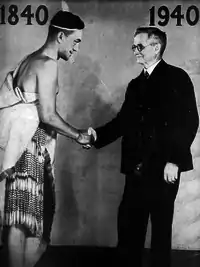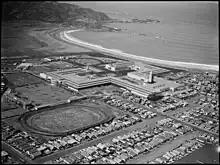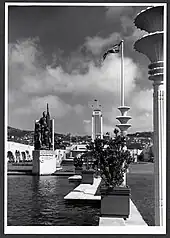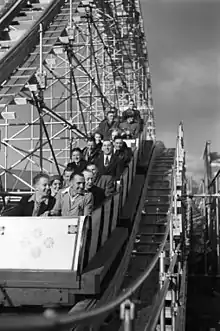
The New Zealand Centennial Exhibition took place over six months from Wednesday 8 November 1939 until 4 May 1940. It celebrated one hundred years since the signing of the Treaty of Waitangi in 1840 and the subsequent mass European settlement of New Zealand. 2,641,043 (2.6 million) visitors attended the exhibition.
The New Zealand Government staged the exhibition with assistance from local government, New Zealand industry and the New Zealand public. The exhibition received support from the United Kingdom, Australia, Canada, Fiji and other Pacific islands who either constructed their own pavilions on site or had displays in one of the exhibition buildings.
Opening
The exhibition was opened on 8 September 1939 by the Governor-General, The Viscount Galway and the Mayor of Wellington, Thomas Hislop. [1] [2] [3] [4]
Location

The exhibition took for its site a location at Rongotai[5] in Wellington, Edmund Anscombe designing the buildings and grounds in the Art Deco style. Construction began on 27 April 1939 by the firm Fletcher and Love Construction Companies and over 1,000 staff were employed in the process of building the exhibition. The exhibition grounds were just over 55 acres (220,000 m2) in size, with the main buildings accounting for around 14 acres (57,000 m2) of this.
Feature structures included:
- the Centennial Tower, the main focus of attention, standing 155 feet (47 m) tall and weighing 700 tons. This icon featured on many of the souvenirs celebrating the exhibition.
- a statue of a Neriad (a sea-woman on a seahorse) standing in the central fountain.
- the New Zealand Railways Department stand featuring a working model-railway constructed to scale and maintained by Frank Roberts (model maker).
2,641,043 (2.6 million) visitors attended the exhibition. The last time an event of such a scale had been held was the New Zealand and South Seas International Exhibition in 1925–26, when 3.2 million visitors were counted at the exhibition in Dunedin.[6] Anscombe had also been the architect for the Dunedin exhibition.[6]
Photography


In February 1938 tenders were invited by the New Zealand Centennial Exhibition Company Ltd for official photographer for the Exhibition. The submission of Eileen Olive Deste (1908–1986) included a testimonial from John A. Lee, under-secretary for housing in the Labour government, for a housing-exhibition project in the Kirkcaldie and Stains gallery in 1937. Deste won the exclusive right to photograph exhibits or any other object in the exhibition buildings or grounds, with a percentage of the gross takings from the sale of the photographs going to the Exhibition Company. The photography rights covered all aspects of the exhibition, from construction to closing. Deste flew above the site in a small plane to take aerial shots, a terrifying but exciting experience, as she later remembered. Deste also entered into an agreement with Coulls Somerville Wilkie Limited to supply photographs for publications and general souvenir material, and her photographs illustrate their Pictorial souvenir of the New Zealand Centennial Exhibition, 1939–1940. Deste's stall in the General Exhibits Building sold photographs and postcards in black and white and colour. Much of the photography at the exhibition came from the camera of an employee, Neville d’Eresby (Des) Aickin, while Deste did the processing and printing at her studio.[7]
New Zealand Potters
In 1939-1940 potters Olive Jones and Elizabeth Matheson demonstrated and sold work at the New Zealand Centennial Exhibition for six months.[8]
Post-exhibition war-time use
Plans envisaged using the building only for six months and then dismantling it. But with New Zealand's ongoing participation in World War II (1939–1945), the New Zealand Air Force used the site and some buildings until the end of the war. In 1946 what remained was burnt to the ground.[9]
See also
Further reading
- Appendices to the House of Representatives, Department of Industries and Commerce, 1941, H-44, pp 21–23.
- Bowron, G. 'A Brilliant Spectacle: the Centennial Exhibition Buildings', in John Wilson (ed.), Zeal and Crusade: the Modern Movement in New Zealand, Christchurch, 1997.
- New Zealand Centennial Exhibition 1939–40: Official Souvenir Catalogue.
- New Zealand Centennial Exhibition Company Ltd archives, held by Wellington City Council Archives.
- Palethorpe, N.B. Official history of the New Zealand Centennial Exhibition, Wellington, 1939–1940. Wellington, 1940.
- Renwick, William (ed.), Creating a National Spirit: Celebrating New Zealand's Centennial. Victoria University Press. Published April 2005. ISBN 0-86473-475-1
References
- ↑ "Opening of Exhibition (photos)". The Evening Post. 9 November 1939 – via Papers Past (photos).
- ↑ "Opening of Exhibition (photos)". The New Zealand Herald. 8 November 1939 – via Papers Past (photos).
- ↑ "Opening of Exhibition (photos)". The Press in Papers Past (photos). 8 November 1939.
- ↑ "Opening of Exhibition (photos)". The Evening Post. 9 November 1939 – via Papers Past.
- ↑ "The Centennial Exhibition - The 1940 Centennial". Nzhistory.net.nz. Retrieved 22 January 2017.
- 1 2 George, Damian (19 November 2016). "Exhibitions cause counting conundrum". The Press. p. A19. Retrieved 22 January 2017.
- ↑ "Deste, Eileen Olive – Biography – Te Ara: The Encyclopedia of New Zealand". Dnzb.govt.nz. Retrieved 22 January 2017.
- ↑ Parker, John. "Olive Emily Jones". Dictionary of New Zealand Biography. Ministry for Culture and Heritage. Retrieved 22 January 2018.
- ↑ Christopher Moor (21 September 2011). "Spectacular fire remembered 65 years on". Stuff.co.nz. Retrieved 22 January 2017.